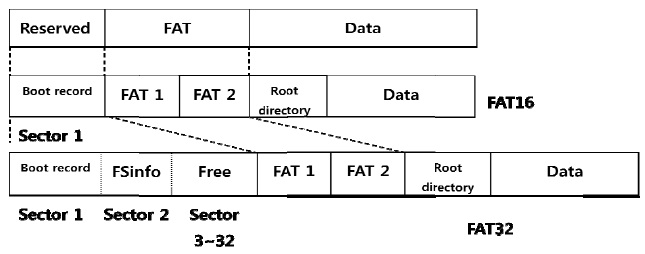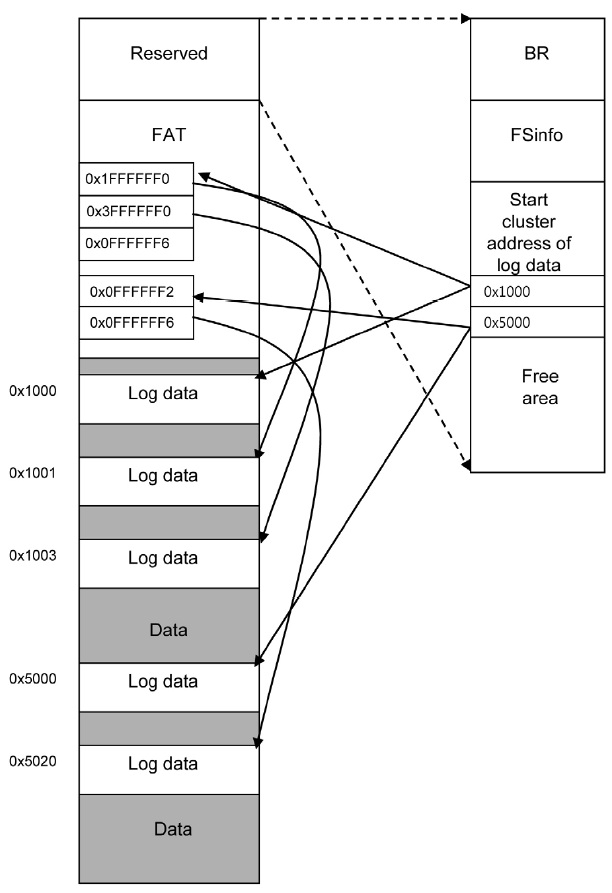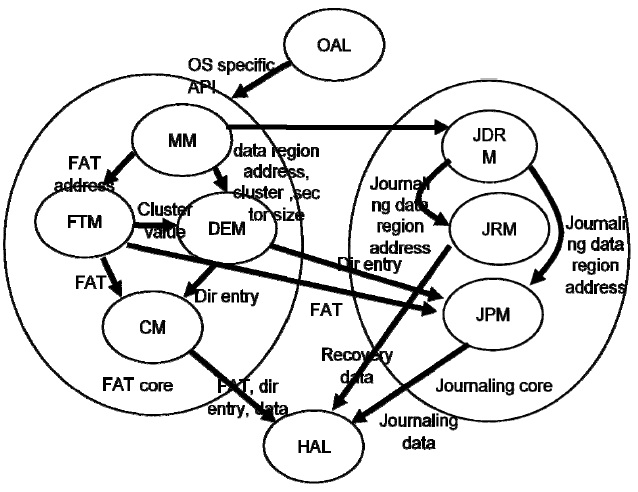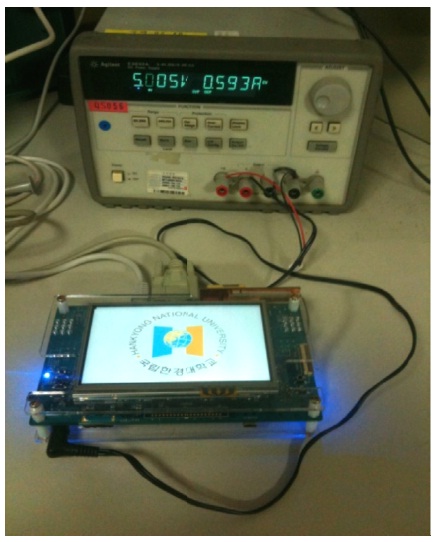



With the development of embedded systems technology, many mobile devices have used mass storage devices and file systems for efficient use of data. Because the file system used on mobile devices should be robust against sudden power failures and system crashes, the use of a journaling file system is needed [1, 2]. Journaling has been mainly used in network server technology [1, 2]. This technology needs data reliability in critical circumstances such as power outages and abnormal termination. Mobile devices also need such reliability to increase their consistency. In addition, mobile devices need to prevent data corruption due to abnormal termination and slow boot time.
Removable storage devices such as USB memory, SD cards, and T-flash, widely used in mobile devices, must use the file allocation table (FAT) file system for windows PC compatibility. However, the FAT file system does not contain journaling, and thus many problems with the consistency of data occur. Therefore, to enhance the consistency of data in removable storage devices with the FAT file system for Windows operating system (OS)-based PC compatibility, several methods have been reported [3-5]. The performance of Microsoft® TFAT [3] is relatively poor because the entire FAT area is backed up whenever the commit occurs. Samsung® KFAT [4] can be damaged easily because the journaling data can be accessible to the user. TILFAT’s method is limited in expansion of the journal data’s size [5].
In this paper, a new method for managing journaling data is introduced. Using the reserved area and reserved FAT entry, the location and quantity of journaling data can be dynamically allocated. The rest of this paper is organized as follows. Section II presents the background for this research and works related to this paper, and Section III describes the structure of the log data and design of Hankyong Journaling FAT (HFAT) used in this paper. In Section IV, the test environment is illustrated and a performance comparison among the implemented HFAT and other approaches is explained. Finally, we provide a summary and conclude in Section V.
II. BACKGROUND AND RELATED WORKS
Storage devices used in embedded systems have often used only a small amount of data. However, with the development of hardware and software technologies such as capacity in recent years, mobile devices can contain storage devices from hundreds of megabytes to several gigabytes.
In order to effectively use the mass storage devices, it is necessary to use a file system. The specific file system used mainly depends on the kind of OS or storage medium. For example, if you use NAND memory on LInux or Android, YAFFS [6] or JFFS2 [7] will be used. Similarly, the exFAT [8] or transaction-safe FAT (TFAT) [3] file system is used in Windows CE (WinCE). However, these kinds of file systems cannot be used in removable storage memory, but in fixed NAND flash memory. In order to run directly on a Windows OS-based PC, a file system should be compatible with the FAT file system. However, the FAT file system does not include a journaling feature. Therefore, several proposals for a FAT file system design with a journaling feature have been reported [3-5].
>
A. Reserved Area and Reserved Cluster Value of Traditional FAT File System
To explain the structure of journaling, the traditional FAT file system is described as follows. The approximate structure of the traditional FAT file system is shown in Fig. 1. FAT16 usually has a reserved area consisting of just one sector to save the boot record. In contrast, FAT32 assigns 32 sectors as a reserved area.
The first sector is the Boot record such as FAT16. The second sector is the file system information (FSInfo) which knows how much free space can be used and where the next free cluster is. Space also exists behind the 30 free sectors. Next to the reserved area is the FAT area, which represents the connection of a cluster data structure as a single linked list. The following Table 1 shows the meaning of the FAT entry [9]. A normal file or derectory begins in the allocated cluster and ends in the end of cluster chain (EOC).
There have been several attempts to add a journaling capability to a FAT file system. TFAT [3], which is employed in WinCE 6.0, has been developed by Microsoft. Originally, the FAT area consisted of FAT1 and FAT2, and FAT1 is the same as FAT2. Typically, FAT2 is set as active working FAT1. All FAT entries are first updated in FAT2 and then the entire FAT2 is copied to FAT1 during the commit. The file/directory updates are performed by allocating a new data cluster and then writing the updated data instead of updating the existing dat cluster. This causes daaitional writes to FAT entries. The root derectory updates of FAT12 and FAT16 are not safe transactions. This is the reason why the root directory in these file systems exists in a fixed location [3]. If one operation is completed, the entire FAT2 area is copied to FAT1. For this reason, performance degradation is severe.
Kwon et al. [4] proposed a new algorithm called KFAT. Unlike TFAT, this method logs all changes such as those of the FAT entries and directory/file entries. During the commit operation, the logged entries are processed, and finally FAT1, FAT2, and directory entries are updated. Typically, the log file is the first file in the root derectory and its size is fixed. It contains 13 different log types. RFS [10] and TFS4 [5] are based on KFAT. TFS4 is specific to SAmsung Electronics oneNAND™ flash memory. The disadvantage of this method is that if journaling is saved as a file format it can be corrupted by a user application. The amount of log data is smaller than the TFAT, but the number of access time exceeds the TFAT.
[Table 1.] FAT entry status values
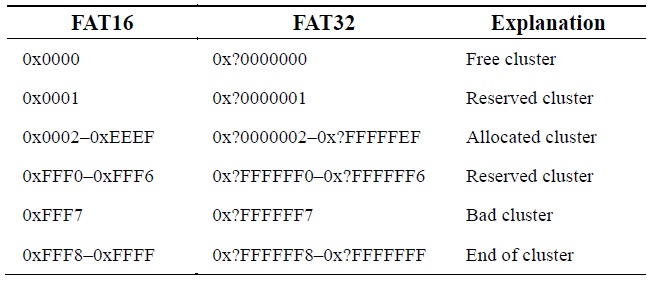
FAT entry status values
[Table 2.] Problems of traditional FAT file system.
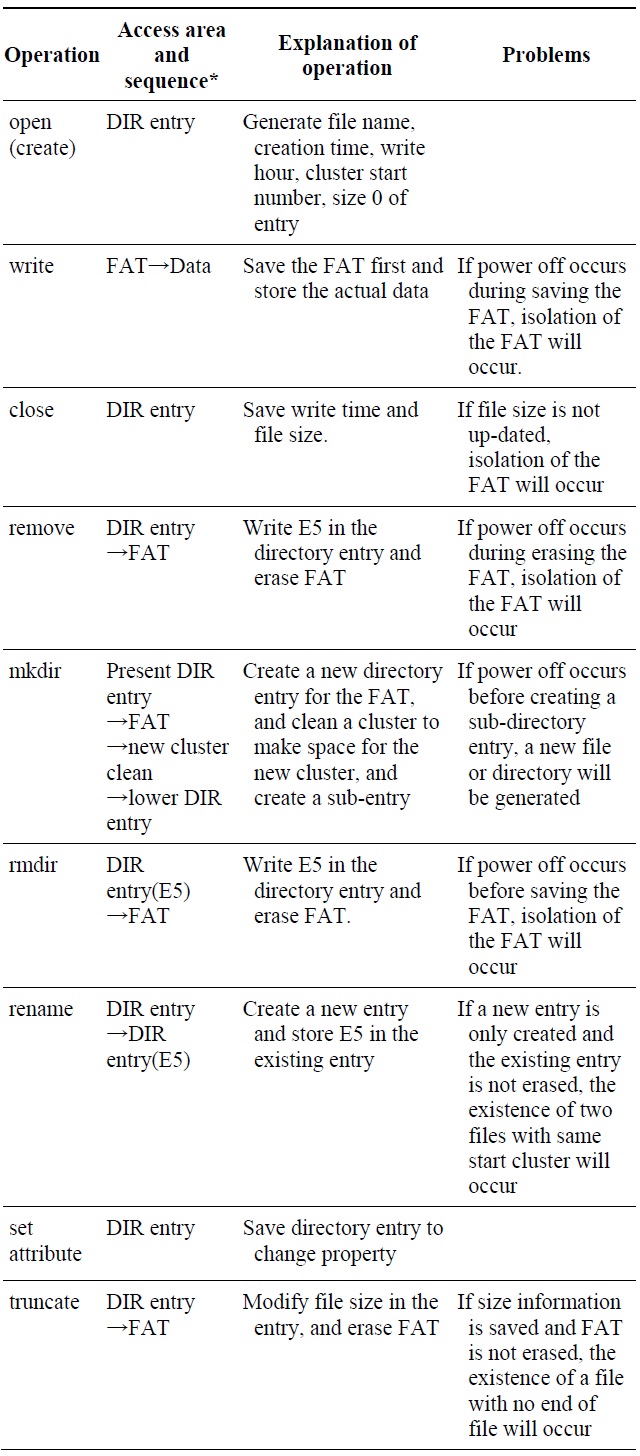
Problems of traditional FAT file system.
Munegowda [5] at Texas Instruments proposed a new method to take advantage of the KFAT and TFAT. FAT entries logging is similar to TFAT. However, the entire FAT2 is not completely copied to FAT1. Only updated FAT2 entries are copied to FAT1. Directory entries logging is similar to KFAT. FAT entry updates are not logged in the log file, but only 32 byte directory entry updates are logged. This method has the disadvantage that the log file is exposed to uwer applications.
>
C. Problems of the TRaditional FAT File System
In the traditional FAT file system with no journaling, the file operations such as file create (open), write, close, remove, re-name, set attribute, make dir, remove dir, and truncate can cause some problems, as shown in Table 2. and it can be understood as the core of this algorithm. Sections Ⅲ-B describes how to implement HFAT. Each file operation accesses a different area and sequence. E5 is an erase operation on a file or directory name. If 0xE5 is written at the beginning of its entry, this entry will be ignored.
III. MANAGEMENT OF LOG DATA FOR HFAT.
Section III-A describes an algorithm which manages the reserved area and FAT area to allocate dynamically the location and size of log data, and it can be understood as the core of this algorithm. Section III-B describes how to implement HFAT.
>
A. The Cluster Number of the Log Data
Journaling of HFAT is not saved as a file format as it is in KFAT. HFAT use the reserved area and the reserved cluster number of the FAT entry, as shown in Table 1. The start cluster number of the log data is saved in the next FSInfo sector of the reserved area. As shown in Table 1. the FAT entry status value of the reserved cluster for FAT32 is 0x?FFFFFF0?0x?FFFFFF6.
Fig. 2 shows the cluster number of the log data using the FAT entry status. The upper 4 bits of the FAT entry status value are reserved, and it does not hae any effect. And the lower 4 bits of the value 0x0?0x6 is can be used. 0x0?0x5 of the lower 4 bits is used as the upper 4 bits of cluster number and 0x6 is defined as end of cluster (EOC). The upper 4 bits of FAT entry status value is used as the lower 4 bits of the cluster number.
In other words, 0x00?0x5F can be assigned to the cluster number. A total of 95 clusters can be used as log data.
The length of the cluster chain can vary within the range of 0x00?0x5F, and the number of cluster chains can increase to more than one. In other words, the cluster number of the log data can allocated dynamically.
Fig. 3 shows an example of using the value of the FAT table for the log cluster chain. In this example, there are two cluster chains. The start cluster number of the first log data is 0x1000 and the second is 0x5000. The corresponding FAT entry of the first cluster chain status value is 0x1FFFFFF0 and that of the second is 0x0FFFFFF2. According to Fig. 2, 0x1FFFFFF0, 0x3FFFFFF0, and 0x0FFFFFF6 represent 0x01, 0x03, and 0x06 (EOC), respectively. In conclusion, the cluster chain of the first log data is 0x1000 → 0x1001 → 0x1003 → 0x60 (EOC), because the starting cluster of the log data is 0x1000. The second log data is 0x5000 → 0x5020 → 0x60 (EOC). This cluster chain cannot be used for general files or directories because these status values are reserved. Using this method, the total storage of the log data can be extended up to 95 clusters, unlike the size and location of the log data in KFAT or TI-LFAT, which remain fixed.
HFAT can be divided into a FAT core module, journaling module, OS abstraction layer (OAL), and hardware abstraction layer (HAL). The descriptions of each module are as follows:
1) FAT core: It performs the original function of the FAT file system. At boot time, it mounts a file system. Then, it manages the FAT table, directory entry, and file data. It can be divided into four modules; mount manager (MM), FAT table manager (FTM), directory entry manager (DEM), and cache manager (CM).
2) Journaling core: It performs the function of producing journaling data and recovering the file system if needed. Depending on the capabilities, it can be divided into three modules; journaling data region manager (JDRM), journaling recovery manager (JRM), and journaling production manager (JPM).
3) OAL: OAL represents the OS abstraction layer. HFAT follows the portable operating system interface (POSIX) standard application programming interface (API).
4) HAL: HAL represents the hardware abstraction layer. It depends on the OS layer.
Fig. 4 illustrates the relationships among the modules and the sequence of HFAT operations. HFAT is mainly divided into the FAT core and journaling core. At boot time, the MM obtains data information such as the log data address, FAT table address, data region address, and sector size. The MM transfers this information to the FTM, DEM, and JDRM. If the JRM finds an unfinished log during mount time, it performs data recovery. The FTM and DEM pass the FAT table and directory entry to the JPM. The JPM generates the journaling data based on this information.
We implemented the HFAT file system and tested it on the mango6410 board [11] on WinCE 6.0. This development board is Samsung S3C6410 ARM11-based mobile device, which has NAND flash and SD/MMC interfaces. The clock speed was 667 MHz. Fig. 5. Shows mango6410 board is used in our experiments. The transactional property of HFAT was tested in the following methods.
The automatic power on/off device is used with the DC power supply (Agilent™ E3633A) controlled by National Instrument™ GPIB device. The interval of power off is generated randomly and usually occurs once every 5?10 minutes. The experiment was performed for 3 months. As a result, there were more than a total of 12,000 on/off power tests. If a problem occurred when mounting the file system, the system would stop. Of course, the degradation of performance using the HFAT occurs naturally. However, on WinCE, it depends mainly on the disk cache policy rather than journal data saving. When we used WinCE disk cache, there was about 15% degradation of performance. However, the self-made cache with the 4 kB disk cache per volume allows direct write operation. In this cse, there was no significant difference in perfomance degradation.
To solve the problems of the traditionasl FAT file system, a new method of journaling with the FAT file system was pro;osed. Because log data is not saved as a file format, user applications cannot access the clog data directly. This will increase the reliability of log data. Because the size of log data can expand to 95 cousters, this is more scalable than other log-based FAT file systems. This method can be used in managing security data as well as log data. In the future, it will be implemented on Android and Linux.
